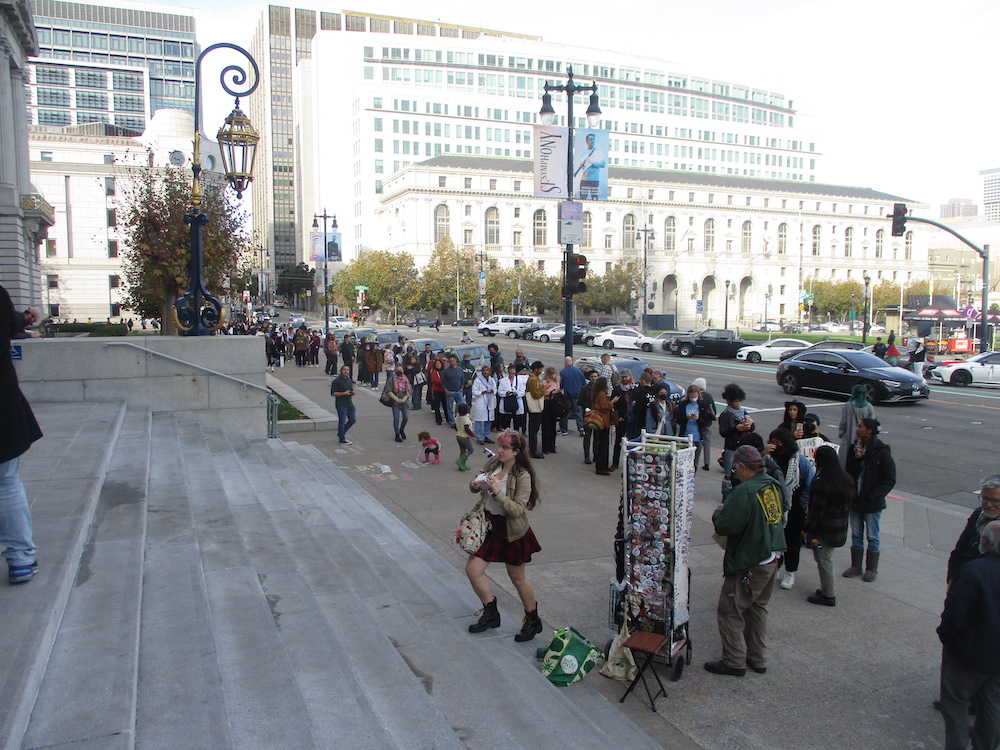More than 2,000 people showed up at City Hall in December to support a resolution by Sups. Dean Preston and Hillary Ronen calling for a ceasefire in Gaza. Since then, the humanitarian crisis is even worse, and polls show increasing support for a halt to the violence.
The resolution had to be sent to committee, and that happened right before the holiday break. But the Rules Committee will hear it Monday/8. It’s expected to go to the full board the next day.
That hearing starts at 10am. If the last meeting is any indication, expect a large crowd and long lines to get into City Hall.

The Chron did a long, detailed story about the almost-completed Golden Gate Bridge suicide barrier Sunday, and left out one of the most important parts:
None of this would have happened without Tom Ammiano.
Ammiano joined the Golden Gate Bridge Board in 1996, as a representative of the Board of Supes, and stayed on that board for the next 12 years. He also served on the Metropolitan Transporation Commission, then went to Sacramento as a member of the state Assembly.
I was there. In all four roles, as an SF supervisor, a Bridge Board member, and MTC member, and an Assemblymember, he pushed tirelessly for a barrier to prevent people from jumping to their deaths from the bridge.
At first, he was almost alone in his effort.
“They make it sound like it just happened,” Ammiano told me. “It was a very long struggle, and very frustrating.”
Some Bridge Board members and staff wanted to talk about aesthetics; some advocates didn’t want to see money that might go for other causes like bike lanes get diverted. Ammiano wanted to talk about saving lives. “It’s like there was no concern for the humanity,” he said.
And yet, he kept it up, year after year. Eventually, after district elections of supes in San Francisco, new people joined the Bridge Board. Then Ammiano was able to push the MTC. “The MTC put up money,” he said. “[Rep.] Barbara Boxer got us money. I got a lot of support in Sacramento. But it was never easy.”
This is not difficult information to find. Anyone who looked back at news reports at the time would find mention of Ammiano. He is not hard to reach.
Paulo Cosulich-Schwartz, a spokesperson for the Bridge Authority, told me that whenever reporters call to ask about the history of the barrier, they mention Ammiano. “It wouldn’t have happened without him,” Cosulich-Schwartz said.
And yet, for all the stories, on the Associated Press wire, in the Chron, and I’m sure more to come, it’s as if Ammiano has been written out of the history. “None of the reporters ever called me,” Ammiano said.
Just for the record.
There’s a curious item on the Budget and Finance Committee agenda for Wednesday/10. It would suspend the requirement that landlords who own vacant or abandoned commercial space register with the Department of Building Inspection and pay an annual fee.
That would also make it harder, maybe impossible, for the Office of the Tax Collector to assess the tax on vacant commercial properties that the voters approved in 2020, since the registration data is used to collect that tax.
The supes suspended that tax during the pandemic, but it’s back on the books. Like the tax on vacant apartments, which the landlords are taking to court, it’s designed not primarily to bring in revenue but to give landlords an incentive not to hold space off the market.
From the Budget and Legislative Analyst report:
According to Carl Nicita, DBI Legislative Affairs Manager, the purpose of the proposed fee waiver is to provide temporary relief to property owners struggling to fill commercial storefront space given the current economic environment.
The poor landlords. It does not appear that DBI has done much outreach to small businesses, or they might have learned what any small business owner looking for a lease in many parts of town will tell you:
It’s not that nobody wants that space. It’s that, to copy an old phrase, the rent is too damn high.
Commercial landlords, who typically sign leases that run for several years or more, are happy to hold space off the market until they can charge more rent; why sign a lease today at a rate that might be lower than what the market will bear three years from now?
That’s the reason the vacancy tax is in place.
The measure will cost the city about $419,000 a year. From the BLA:
According to Alex Lewis-Koskinen, DBI Deputy Director of Administrative Services, the DBI FY 2023-24 budget did not contemplate the proposed fee waiver. To make up for potential revenue reductions, the department would have to reduce expenditures, exceed projected revenues in other areas, or utilize its reserve funds. Despite introduction of this ordinance in July 2023, DBI has not finalized a funding plan for the proposed reduction in revenue.
Okay: So the city loses money (and this doesn’t even count the amount lost because of the inability to assess the vacant property tax). DBI, at a time when every department is supposed to cut costs, has no plan to replace that money.
And it’s all in the name of helping commercial property owners keep storefronts off the market so they can hold out for higher rents in the future—damaging neighborhoods and communities in the process.
That meeting starts at 10am.



